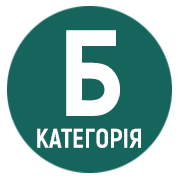“MUSEUMS” OF THOSE BORN IN THE USSR: IMAGES OF SOVIET EVERYDAY LIFE IN NINA KURYATA'S NOVEL “DZVINKA…”
DOI:
https://doi.org/10.32782/2412-933X/2025-XXIV-3Keywords:
poetics of everyday life, Soviet past, contemporary prose, paradox, irony, antithesis, images of thingsAbstract
The purpose of this study is to characterize the specifics of the author’s poetics of Soviet everyday life in Nina Kuriata’s novel “Dzvinka. A Ukrainian Born in the USSR”. To achieve this goal, the author describes the images of everyday things through the worldview of the child character and draws attention to the problem of doublethink in Soviet society. The author condemns the primitiveness of everyday life as the ideological essence of total communist domination.The study uses several methods: formal, comparative-historical, comparative-comparative, and biographical.It has been found that the images of toys, clothes, school supplies, homemade food, etc. have the effect of documentary photography and illustrate memories of the experience. The main meanings in the depiction of Soviet everyday life are paradoxical; emphasizing the absurdity and inconsistency with people’s needs; contrast between ideological and spiritual values; irony in revealing the “Soviet” adaptability; subtextual generalizations. The contrast between the two worlds – the domestic (personal) and the public (collective) – is represented by visual images: a cross and an October Revolutionary star, church banners and a red flag as a symbol of a communist holiday. Contextual antithesis is used to emphasize the differences in the family environment: luxury in the city apartment of the KGB uncle and simplicity in the rural house of the Dzvinka family.It is emphasized that the concept of home, the “apologetics of home”, is crucial in the artistic reception of Soviet everyday life. The author’s reinterpretation of the past relies on places of memory, and the image of things ensures the museumization of the space of memories.Nina Kuryata’s novel reveals two artistic time-spaces: 1) visual (reconstruction of past events), where images of things provide retrochronicles and play the role of museum exhibits; 2) sensual (reflection of the author’s memory), where objects are perceived as objects of critical analysis of the experience.The study of the poetics of Soviet everyday life in Nina Kuriata’s novel opens up the possibility of further research into this problem in other texts of fiction about the colonial past.
References
Ассман А. Простори спогаду: Форми та трансформації культурної пам’яті / пер. з нім. К. Дмитренко, Л. Доронічева, О. Юдін. Київ : Ніка-Центр, 2014. 440 с.
Бродель Ф. Матеріальна цивілізація, економіка і капіталізм ХV–ХVІІ ст. : в 3 т. Київ : Основи, 1995. Т. 1. Структури повсякденності: можливе і неможливе. 543 с.
Буцька К. Музеєфікація повсякдення: побут як простір пам’яті про епоху, що пішла. Сучасні літературознавчі студії. 2021. № 18. С. 6–12. URL: https://doi.org/10.32589/2411-3883.18.2021.246709 (дата звернення: 23.01.2025).
Ваннер К. Тягар мрій: Історія та ідентичність у пострадянській Україні / пер. з англ. Юлії Буйських. Київ : Дух і літера, 2023. 316 с.
Гогохія Н. Якісні методи дослідження у вивченні радянської повсякденності 1920–30-х рр. Вісник Луганського національного педагогічного університету ім. Т.Г. Шевченка. 2007. № 23. С. 109–114.
Гребенюк Т. Спільний біль, війна й ідентичність: національна специфіка українського літературного метамодернізму. Від пост-до метамодернізму: зміна культурної парадигми сучасності. Сучасні літературознавчі студії. 2023. № 20. С. 30–58. URL: https://doi.org/10.32589/2411-3883.20. 2023.293539 (дата звернення: 23.01.2025).
Демська-Будзуляк Л. Літературна репрезентація страху у дискурсі повсякденності радянської України 1930-х років (на прикладі роману «Страх» Олени Звичайної). Сучасні літературознавчі студії. 2021. № 18. С. 37–43. URL: https://doi.org/10.32589/2411-3883.18.2021.246823 (дата звернення: 23.01.2025).
Дракуліч С. Як ми пережили комунізм і навіть сміялися / пер. з англійської Р. Свято. Київ : Yakaboo Publishing, 2019. 208 с.
Дуда Н. Трансформація побутової культури в радянській повсякденності. Історія радянської повсякденності : на перехресті джерел: матеріали Всеукраїнського науково-теоретичного семінару. 14-15 травня 2015 р., м. Вінниця / відп. ред. : О.А. Коляструк. Вінниця, 2015. С. 40–46.
Забужко О.С. «Вартові руїни» : місто дитинства і механіка письма. Суспільне. Культура. URL: https://www.youtube.com/watch?v=6lYqlFqjAfo&t=3883s (дата звернення: 25.01.2025).
Карпа І. З роси, з води і з калабані. Харків : Книжковий Клуб «Клуб Сімейного Дозвілля», 2015. 320 с.
Киридон А. Гетеротопії пам’яті: Теоретико-методологічні проблеми студій пам’ять. Київ : Ніка-Центр, 2016. 320 с.
Коляструк О. Повсякденність як об’єкт історичного дослідження: окремі методологічні зауваження. Література та культура Полісся. 2009. № 52. С. 187–195.
Коляструк О. Повсякденне життя інтелігенції УРСР у 1920-ті рр. сучасний теоретико-методологічний та історіографічно-джерелознавчий дискурс : дис. …докт. іст. наук : 07.00. 06. Київ, 2010. 386 с.
Кур’ята Н. Дзвінка. Українка, народжена в СРСР. Київ : Лабораторія, 2023. 376 с.
Нора П. Теперішнє, нація, пам’ять / пер. з фр. А. Рєпи. Київ : ТОВ Видавництво «КЛІО», 2014. 272 с.
Петренко Т. Ревізія радянського спадку: роман Ніни Кур’яти «Дзвінка. Українка, народжена в СРСР». Читомо. URL: https://chytomo.com/reviziia-radianskoho-spadku-roman-niny-kur-iaty-dzvinka-ukrainka-narodzhena-v-srsr/ (дата звернення: 30.11.2025).
Поліщук Я. Пошуки Східної Європи: тіні минулого, міражі майбутнього. Чернівці : Книги – ХХІ, 2020. 192 с.
Тарнашинська Л. Феномен повсякдення в структурі буденної свідомості героїв Валерія Шевчука: філософсько-літературознавчий аспект. Волинь–Житомирщина. 2010. № 20. С. 158–175.
Удод О. Історія повсякденності як методологічна проблема (про актуальність історії повсякденності). Сумський історичний портал. URL: https://history.sumy.ua/theoryofhistory/226 (дата звернення: 23. 03.2025).
«Це книжка про ідентичність і шлях» – Анастасія Левкова про роман «Дзвінка. Українка, народжена в СРСР». Лабораторія. URL: https://laboratoria.pro/blog/tse-knyzhka-pro-identychnist-i-shlyah--anastasiya-levkova-pro-roman-dzvinka-ukrainka-narodzhena-v-srsr (дата звернення: 02.02.2025).
Чиркова Л. Героїня є дзеркалом суспільства: Ніна Кур’ята розповіла про роман «Дзвінка». Суспільне. Культура. URL: https://suspilne.media/culture/622075-geroina-e-dzerkalom-suspilstva-nina-kurata-rozpovila-pro-roman-dzvinka/ (дата звернення: 23.01.2025).
Шльоґель К. Археологія комунізму, або Росія у ХХ столітті. Реконструкція картини. / пер. з нім. І. Витрикуш. Київ : Дух і літера, 2018. 120 с.
Шюц А., Лукман Т. Структури життєсвіту / пер. з нім. та післямова В. Кебуладзе. Київ : Український Центр духовної культури, 2004. 560 с.
Hałas E. Time and memory: a cultural perspective. Trames. № 14. Р. 307–322. URL: https://doi.org/10.3176/tr.2010.4.02 (дата звернення: 30.01.2025).
Langbauer L. Novels of everyday life: the series in English fiction, I850–I930. Cornell University Press. Ithaca and London. 1990. 304 p. URL: https://books.google.com.ua/books?id=_iZmqoBCbuUC&printsec=frontcover&hl=uk&source=gbs_ge_summary_r&cad=0#v=onepage&q&f=false (дата звернення: 17.01.2025).
Maffesoli M. The sociology of everyday life (epistemological elements). Current Sociology. Vol. 37. 1989. P. 1–16. URL: https://journals.sagepub.com/doi/abs/10.1177/001139289037001003 (дата звернення: 02.02.2025).
Popescu M. Imaging the Past: Cultural Memory in Dubravka Ugresic's The Museum of Unconditional Surrender. Studies in the Novel. Unconditional Surrender. 2007. № 39. Р. 336–356. URL: https://www.dubravkaugresic.com/writings/wp-content/uploads/2016/07/Monica_Article_Studies_in_the_Novel.pdf (дата звернення: 29.01.2025).
2Winter J. Sites of Memory and the Shadow of War. Cultural Memory: an International and Interdisciplinary Handbook / edited by Erll Astrid, Nunning Ansgar. Berlin : Walter de Gruyter GmbH & Co. 2008. pp. 61–76.






